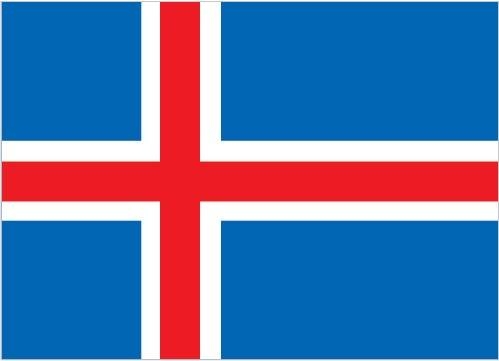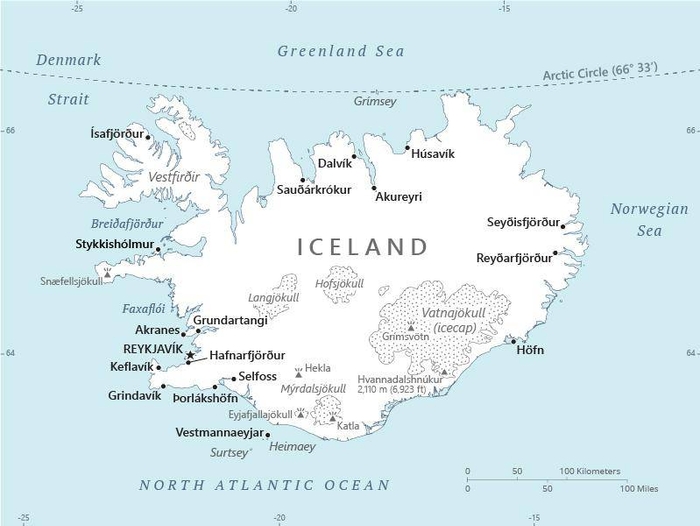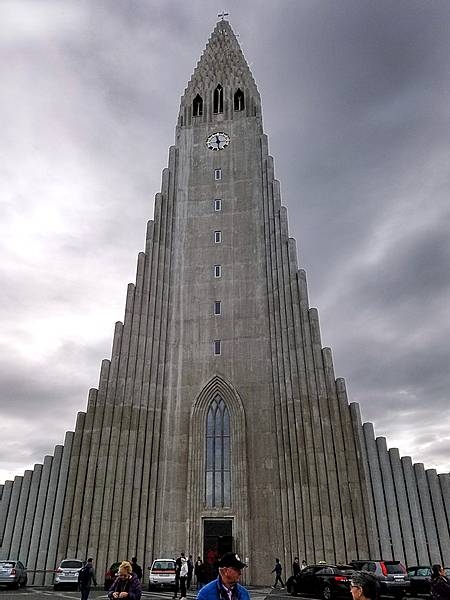83 Iceland

Blue with a red cross outlined in white extending to the edges of the flag. The vertical part of the cross is shifted to the hoist side in the style of the Dannebrog (Danish flag). The colors represent three of the elements that make up the island: red is for the island’s volcanic fires, white recalls the snow and ice fields of the island, and blue is for the surrounding ocean.
Flag courtesy of the CIA World Factbook

Map courtesy of the CIA World Factbook

Hallsgrimskirkja is a Lutheran church in Reykjavik that was built between 1945 and 1986. Its spire of 74.5 m makes it is one of the tallest buildings in Iceland.
Photo courtesy of the CIA World Factbook
Government
According to Britannica, Iceland’s constitution, which was adopted in 1944, established a parliamentary democracy with a directly elected president as head of state. The powers of the president are similar to those of other heads of state in western European democracies. Real power rests with the 63-member parliament, the Althingi (Althing). One of the oldest legislative assemblies in the world, it is a unicameral legislature in which members serve four-year terms unless parliament is dissolved and new elections called. The executive branch is headed by a cabinet that must maintain majority support in parliament, or at least avoid censure, otherwise it must resign. Citizens are guaranteed the civil rights customary in Western democracies.
Local government in Iceland is chiefly responsible for primary education, municipal services, and the administration of social programs. The country is divided into 17 provinces (sýslur), which are further subdivided into fewer than 100 municipalities. Since the 1970s their number has decreased by nearly half as a result of consolidation. Each municipality administers local matters through an elected council.
The judiciary consists of a supreme court and a system of lower courts, most of which hear both civil and criminal cases. Cases are heard and decided by appointed judges; there is no jury system.
Icelandic Transport Authority
The Icelandic Transport Authority is the administrative institution for transport affairs in accordance with an Act dated 30 November 2012. The Authority is subject to the Ministry of Transport and Local Government and is intended to contribute to safe, sustainable, accessible and economical transport. The Icelandic Transport Authority manages the administration of transport affairs and conducts oversight pertaining to aviation, maritime affairs, traffic and safety oversight of transport structures and navigation. All tasks that were previously subject to the Icelandic Civil Aviation Administration and the Road Traffic Directorate have been taken over by the Icelandic Transport Authority, in addition to administrative and oversight tasks of the Icelandic Maritime Administration and licensing and traffic-monitoring services that the Icelandic Road and Coastal Administration was previously in charge of. Concurrently, operational tasks of the Icelandic Maritime Administration were transferred to the Icelandic Road and Coastal Administration. It should be noted that all documents bearing the title of the Icelandic Civil Aviation Administration, Icelandic Maritime Administration and Road Traffic Directorate will continue to be valid and issued operating licenses will be valid through their defined period of validity.
Airspace
SkyVector – Google Maps – ADS-B Exchange
ICAO countries publish an Aeronautical Information Publication (AIP). This document is divided into three parts: General (GEN), En Route (ENR) and Aerodromes (AD). ENR 1.4 details the types of airspace classes they chose to adopt from classes A through G.
Drone Regulations
Advanced Air Mobility (AAM) Regulations & Policies
Bilateral agreements facilitate the reciprocal airworthiness certification of civil aeronautical products imported/exported between two signatory countries. A Bilateral Airworthiness Agreement (BAA) or Bilateral Aviation Safety Agreement (BASA) with Implementation Procedures for Airworthiness (IPA) provides for airworthiness technical cooperation between the FAA and its counterpart civil aviation authorities.
Bilateral Aviation Safety Agreement – Executive Agreement
Implementation Procedures for Airworthiness
2016 Notification of Policy Deviation Memorandum for FAA Order 8130.21H
Advanced Air Mobility (AAM) News
2021 – WIDEROE EXPLORES THE POTENTIAL FOR A SCANDINAVIAN URBAN AIR MOBILITY NETWORK
Short Essay Questions
Scenario-Based Question
You have been hired by a Drone Startup Company. Your boss has immediately assigned this job to you.
They need you to prepare a one-page memo detailing the legalities of using a drone to film in Reykjavik, pictured above.
They need you to mention any national laws and local ordinances.
They specifically want to know what airspace (insert pictures) you will be operating in and whether or not you need an airspace authorization.
Does it matter whether or not you are a citizen of the country?
Lastly, there is a bonus for you if, as you scroll through this chapter, you find any typos or broken links!
Short Essay Questions
- What are the drone categories?
- How is registration addressed?
- How is remote ID addressed?
- What are the model aircraft rules?
- What are the commercial drone rules?
- Are there waivers or exemptions to the rules? If so, for what?
- Would you share a link to an interactive airspace map?
- How is BVLOS addressed?
- How can you fly drones at night?
- How can you fly drones over people?
- Where do you find drone NOTAMs?
- What are the rules for drone maintenance?
- What are the rules for an SMS program?
- What are some unique rules not mentioned above?
- What are the C-UAS rules?
- What are the AAM rules?

